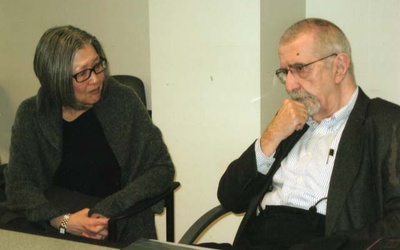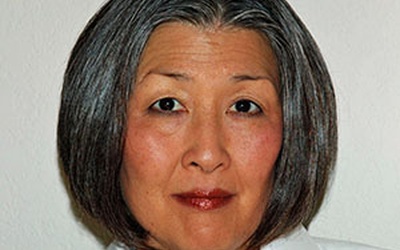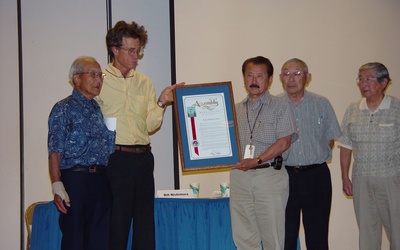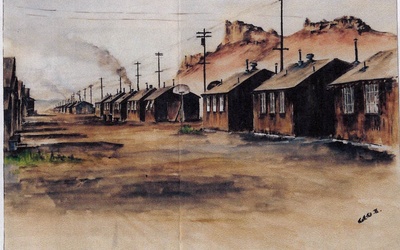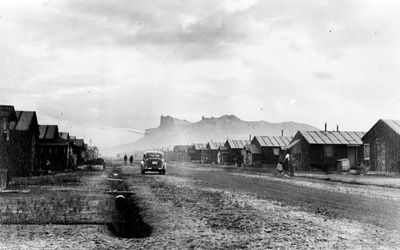
Barbara Takei
@barbaratakeiBarbara Takei es una sansei nacida en Detroit cuya introducción al movimiento asiático-estadounidense a finales de los años 60 fue Grace Lee Boggs y la Alianza Política Asiática de Detroit. Durante décadas estuvo intrigada por las historias faltantes de la disidencia japonesa-estadounidense contra el injusto encarcelamiento, pero no fue hasta su primera peregrinación al lago Tule en 2000 que se dio cuenta de que las protestas pacíficas durante la Segunda Guerra Mundial habían sido borradas al demonizarlas como “deslealtad pro-Japón”. Durante las últimas dos décadas, se ha desempeñado como funcionaria del Comité del Lago Tule, una organización sin fines de lucro, y se dedicó a preservar el Lago Tule como el lugar de la resistencia de los estadounidenses de origen japonés por los derechos civiles.
Actualizado en enero de 2023
Historias de Este Autor
Recordando a Roger Daniels
29 de enero de 2023 • Barbara Takei
El primer libro que leí sobre la historia japonés-estadounidense fue el de Roger Daniels, "La política del prejuicio". Era 1966, y en mi investigación como estudiante de primer año de la universidad, era el raro libro sobre la historia japonés-estadounidense, uno que inició la larga e ilustre carrera de Roger como historiador que documenta la historia de los japoneses-estadounidenses y el encarcelamiento en tiempos de guerra. Durante el siguiente medio siglo, la erudición de Roger fue la base de la …
Does Terminology Matter?
3 de junio de 2013 • Barbara Takei
In recent years, the Nikkei community has engaged in a renewed discussion to reject the euphemistic and false terms the government used to minimize the unjust and inhumane nature of the Japanese American incarceration. From 2009 through 2011, the Japanese American National Museum, the Manzanar Committee, the Tule Lake Committee, and UCLA’s George & Sakaye Aratani Chair in Japanese American Incarceration, Redress, and Community organized workshops and community-wide symposiums in Southern and Northern California to stimulate discussion and develop consensus …
Legalizing Detention: Segregated Japanese Americans and the Justice Department’s Renunciation Program - Part 9 of 9
10 de mayo de 2013 • Barbara Takei
Read Part 8 >> The government pursued a hard line, determined to challenge the bid of each renunciant who sought restoration of citizenship. In bleak contrast to Goodman’s decision to restore citizenship en masse, the DOJ began sorting renunciants into 22 categories of offenses it characterized as serious enough to deny restoration of citizenship.1 Collins wound up spending many years battling the negative administrative classifications the DOJ assigned to his thousands of individual clients. Collins faced opposition not only from the …
Legalizing Detention: Segregated Japanese Americans and the Justice Department’s Renunciation Program - Part 8 of 9
3 de mayo de 2013 • Barbara Takei
Read Part 7 >> Creating Alien Enemies Edward Ennis’ Deputy in the DOJ Alien Enemy Control Unit, John Burling, was the designated hearing officer for the renunciation hearings at Tule Lake. Burling said that the renunciation hearings would be a careful, deliberate process, making it difficult to renounce. Instead, the DOJ set up what amounted to a deportation mill, stripping Americans of their citizenship and providing the government with a legal fig-leaf that justified the individual detentions. Burling even recommended “accepting these …
Legalizing Detention: Segregated Japanese Americans and the Justice Department’s Renunciation Program - Part 7 of 9
26 de abril de 2013 • Barbara Takei
Read Part 6 >> Why Did They Renounce? After its publication in 1946, The Spoilage remained for many decades the primary source on Tule Lake. This seminal work cited allegations of harassment by pro-Japan groups that led to the mass renunciations, using field notes written after the war ended, September 25, 1945 and December 19, 1945.1 Renunciants who sought to regain their U.S. citizenship from the Department of Justice recognized that the desired explanation for their renunciation was to blame the pro-Japan …
Legalizing Detention: Segregated Japanese Americans and the Justice Department’s Renunciation Program - Part 6 of 9
19 de abril de 2013 • Barbara Takei
Read Part 5 >> Stampede to Renounce Public Law 405, authored by U.S. Attorney General Francis Biddle, permitted American citizens to renounce their citizenship during time of war. Congress passed it and President Roosevelt signed it into law on July 1, 1944. This denationalization law was directed at the Japanese Americans in Tule Lake after widespread newspaper coverage of the November 1943 disturbances at Tule Lake led to “intensification of the idea that some law should be passed depriving these people of …
Legalizing Detention: Segregated Japanese Americans and the Justice Department’s Renunciation Program - Part 5 of 9
12 de abril de 2013 • Barbara Takei
Read Part 4 >> Western Defense Command Preparation for Individual Detention On December 17, 1944, Major General H. C. Pratt, Commander, WDC, rescinded the Mass Exclusion Order that ordered all Japanese Americans removed from the West Coast. Effective January 2, 1945, individual disloyalty, instead of race, would be used as the test for exclusion from the Pacific States. It also provided that “any person of Japanese ancestry about whom there is available information indicating disloyalty will continue to be excluded on an …
Legalizing Detention: Segregated Japanese Americans and the Justice Department’s Renunciation Program - Part 4 of 9
5 de abril de 2013 • Barbara Takei
Read Part 3 >>End of Army OccupationThe WRA and the Army had very different organizational dynamics, and their relationship was often tense and fraught with disagreement. Conflict over management of the stockade climaxed on May 23, 1944, when the WRA’s Board of Inquiry approved the release of two inmates, while the Army disapproved their release. After a conference between WRA and Army officials on May 24, 1944, Director Best, by letter to Lt. Col. Verne Austin, Commander, 752nd Military Police …
Legalizing Detention: Segregated Japanese Americans and the Justice Department’s Renunciation Program - Part 3 of 9
29 de marzo de 2013 • Barbara Takei
Read Part 2 >> The Stockade: Symbol of the Worthlessness of U.S. CitizenshipWith the Center’s elected leaders imprisoned in the stockade, the stockade became the omnipresent reminder of the keepers’ arbitrary use of power at Tule Lake. It was an evocative reminder of the unjust post-Pearl Harbor roundups of Japanese American community leaders who were singled out and imprisoned, punished for their prominence and leadership. In a 15-page letter written September 19, 1944 to U.S. Attorney General Francis Biddle,1 a group …
Legalizing Detention: Segregated Japanese Americans and the Justice Department’s Renunciation Program - Part 2 of 9
22 de marzo de 2013 • Barbara Takei
Read Part 1 >> Martial Law With most of the elected Nikkei leadership imprisoned in the stockade, Commander Austin made plans for a mass public meeting on November 13, 1943 to be attended by the Army and WRA and the Negotiating Committee. This mass meeting never materialized as the prisoner population did not show up. Only the Army and WRA were present; they conducted their program without an audience. Commander Austin made proclamations to govern operation of the center, which, in effect, …

